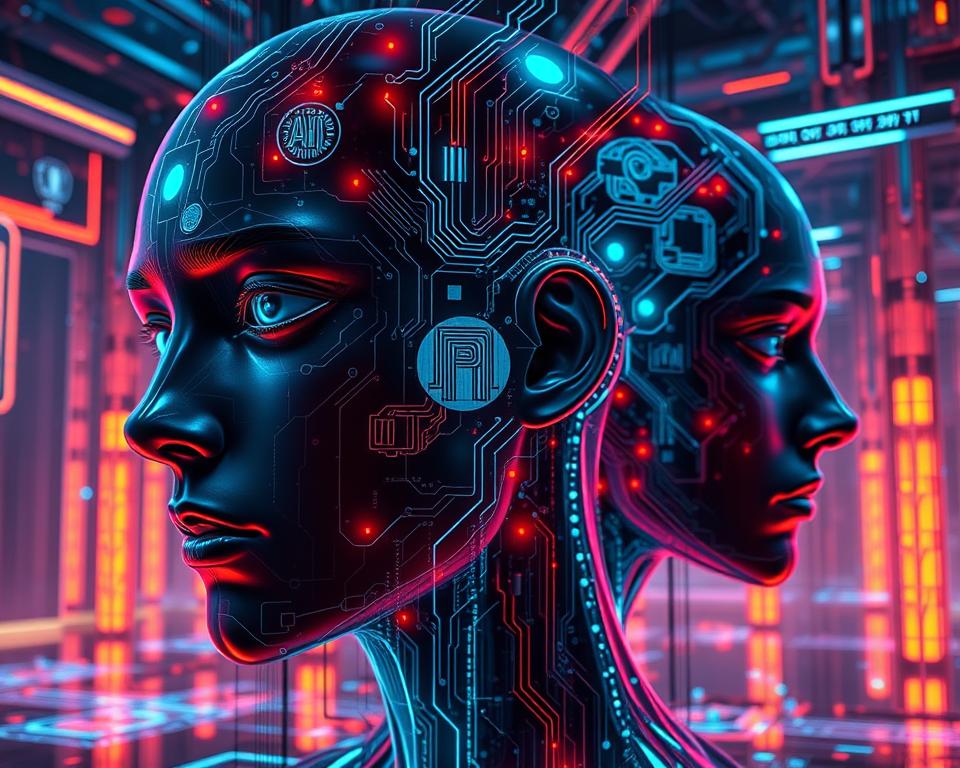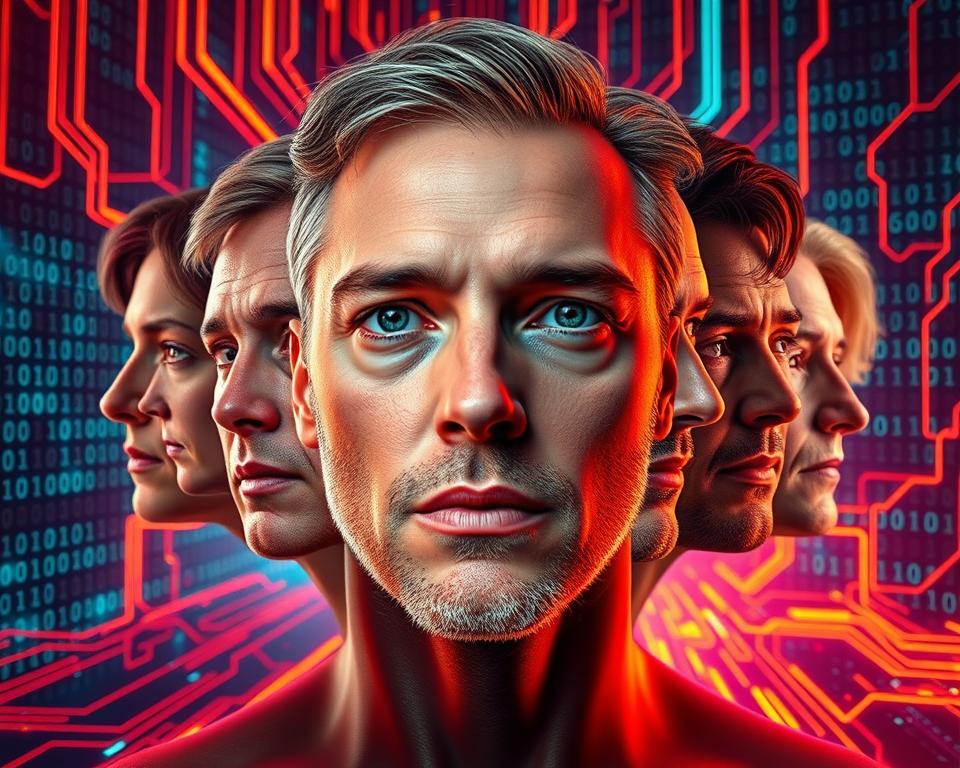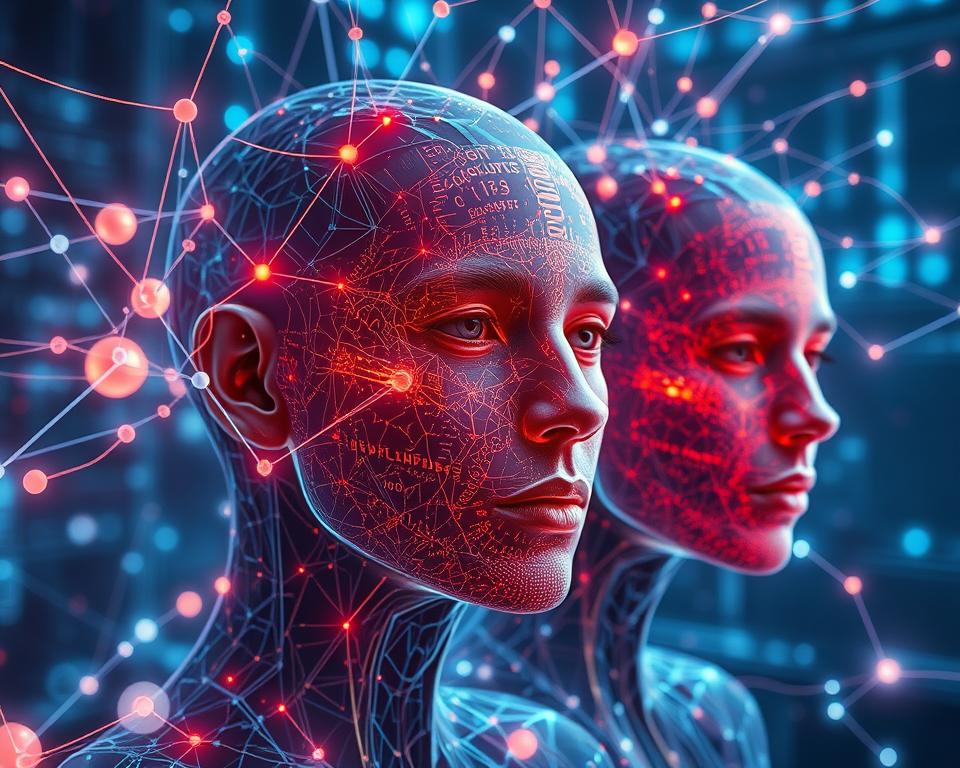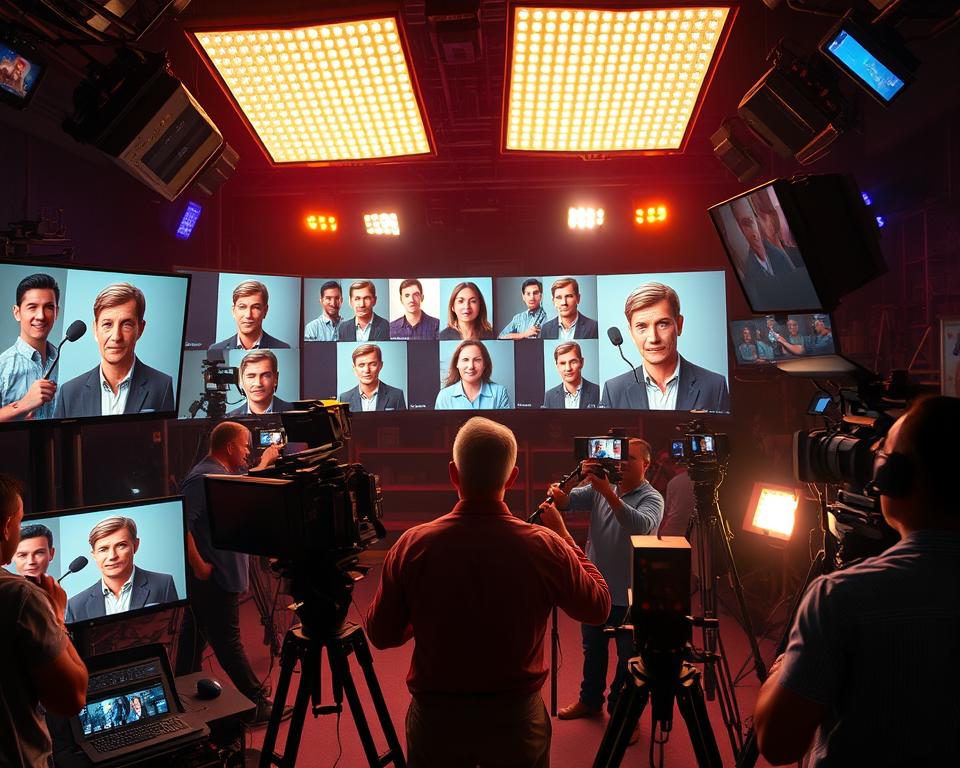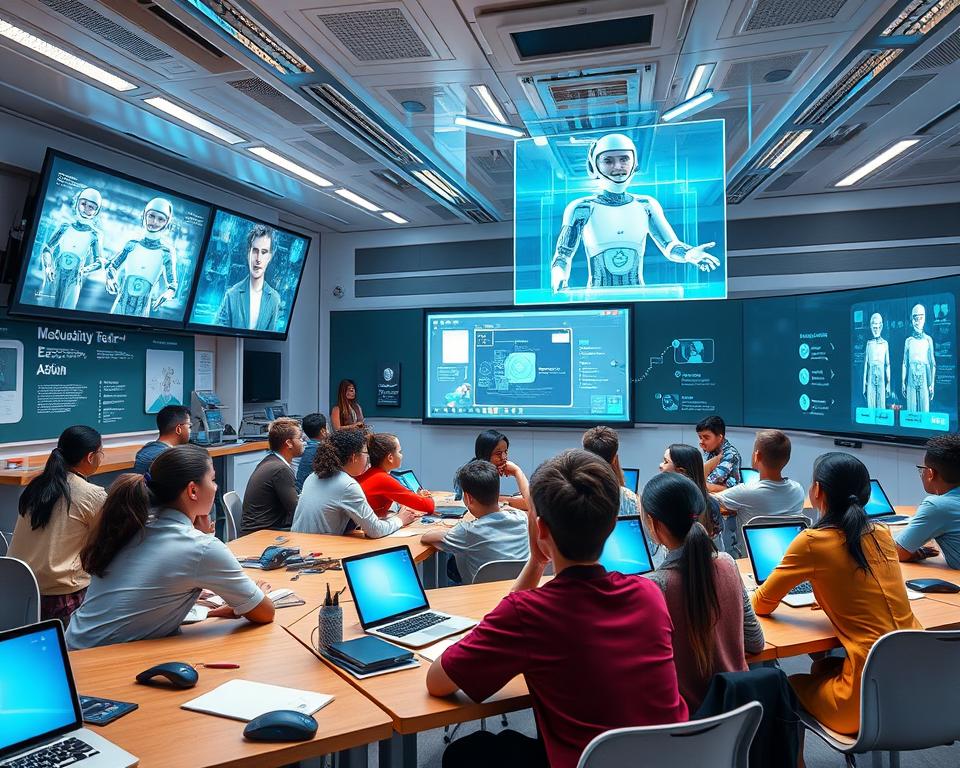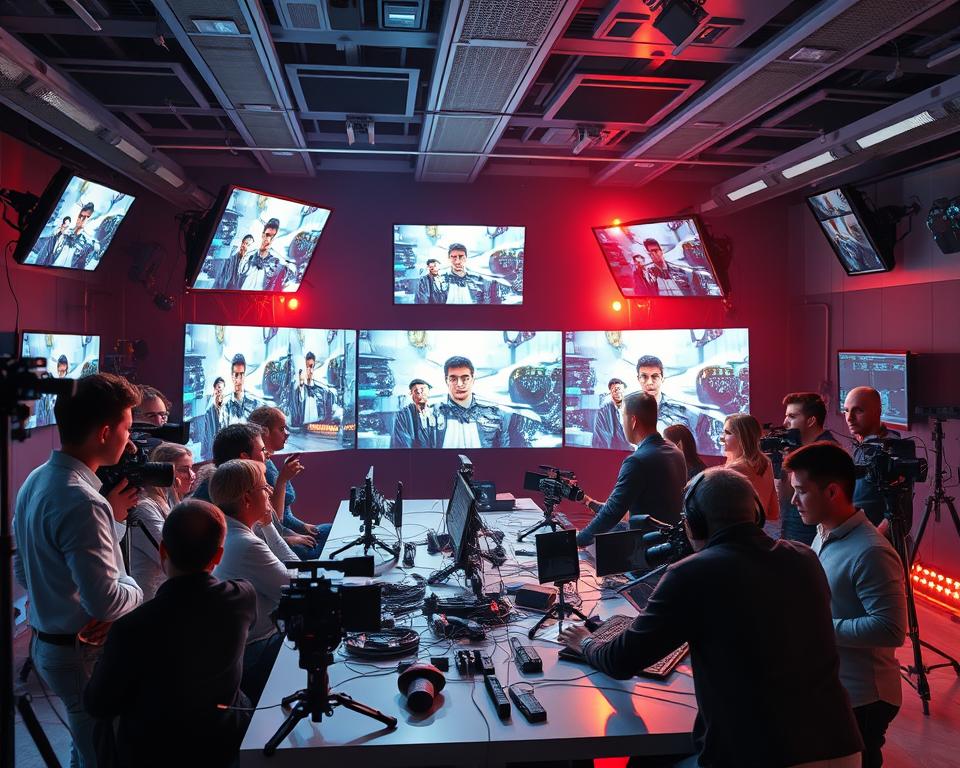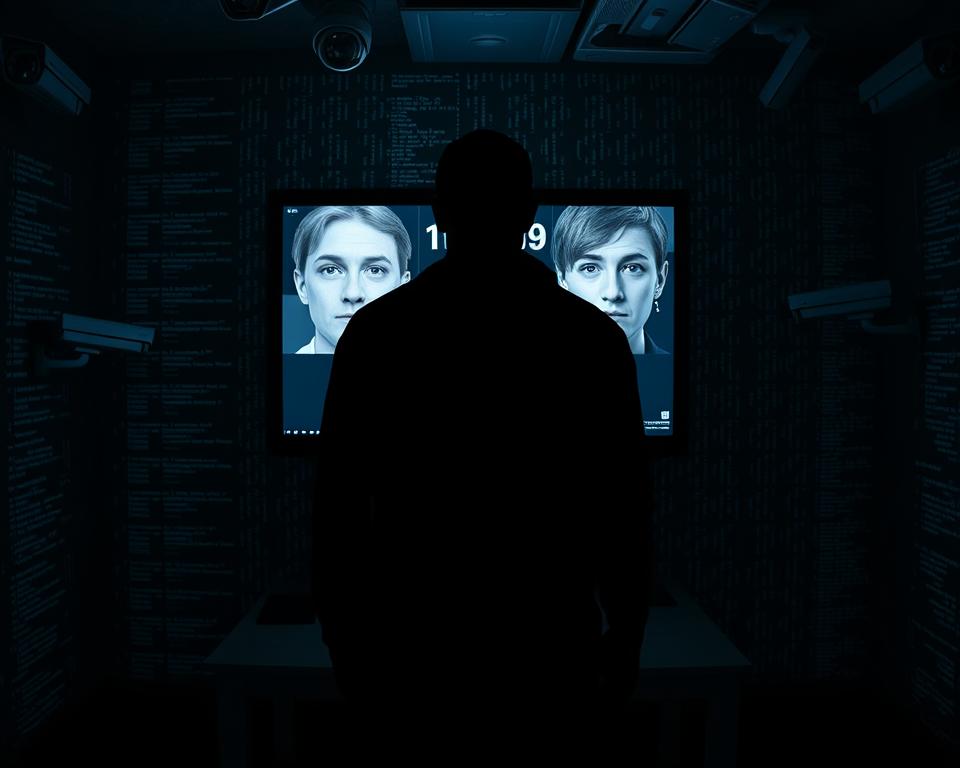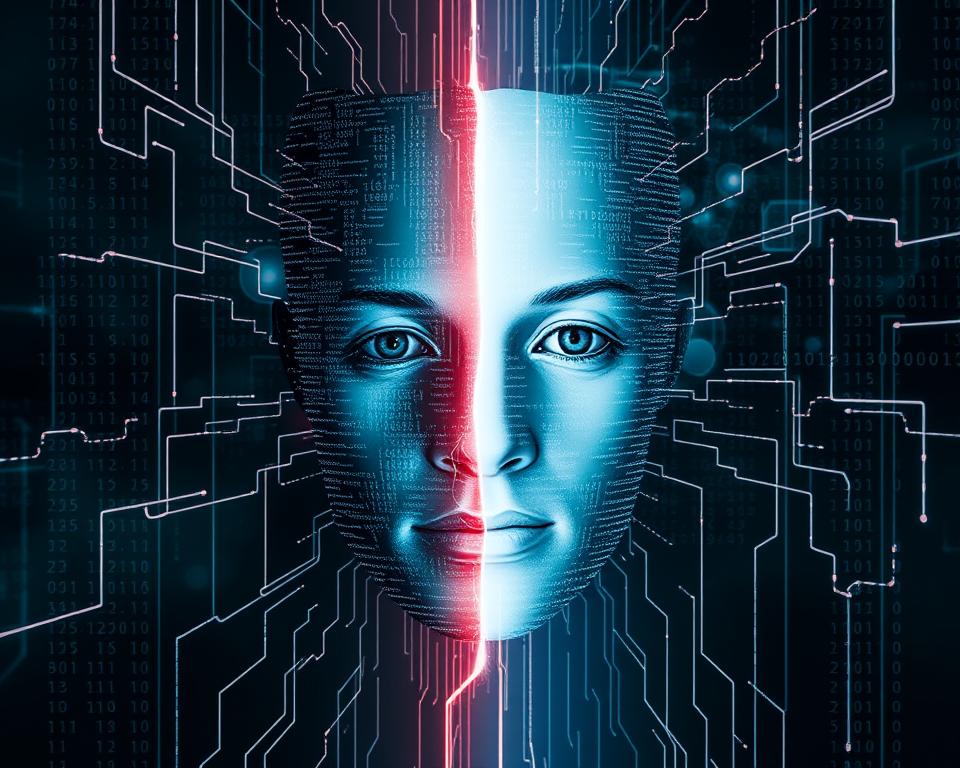Deepfake AI uses machine learning to make digital content look real. This includes videos, images, and audio. It’s getting a lot of attention because it could change many fields like entertainment, education, and marketing.
Deepfake AI combines artificial intelligence and machine learning to make digital content. This technology is growing fast. It will change how we use digital media in many areas.
Deepfake AI has huge potential to change industries. Companies and researchers worldwide are exploring its uses. By understanding deepfake AI, we can use it in new ways.
Table of Contents
Introduction to Deepfake AI
Deepfake AI is a fast-growing field. It’s driven by advances in artificial intelligence and machine learning. This technology will impact many industries, from entertainment to marketing.
Key Takeaways
- Deepfake AI is a subset of artificial intelligence that utilizes machine learning algorithms to create realistic digital content.
- The technology has the potential to revolutionize various industries, including entertainment, education, and marketing.
- Deepfake AI is being driven by advances in artificial intelligence, machine learning, and related technologies.
- The integration of deepfake AI, artificial intelligence, and machine learning algorithms enables the creation of sophisticated digital content.
- Deepfake AI has the potential to transform industries and unlock new ways to utilize this technology.
- The applications of deepfake AI are being explored by companies and researchers around the world.
What is Deepfake AI and Its Potential
Deepfake AI uses machine learning to make digital content like videos and images. It’s been getting better over time. Now, it’s used in entertainment, education, and marketing.
The term “deepfake” means using Deepfake Technology to make fake content that looks real. It started in the early 2000s with machine learning for image and video processing. Now, it creates Synthetic Media that looks very real and engaging.
Definition and Core Concepts
Deepfake AI works with machine learning algorithms and neural networks. These tools help make fake videos, images, and audio that look real. The main idea is to make synthetic media that’s realistic and fun to watch.
Historical Development
Deepfake AI has grown fast, with big steps forward in recent years. It’s now used in entertainment, education, and marketing. Its potential is huge, and it will likely keep getting better.
Key Technologies Behind Deepfakes
Generative adversarial networks (GANs) and convolutional neural networks (CNNs) are key. They help make digital content like videos and images look real. These technologies are used in many areas, including entertainment and education.
The Technical Foundation of Deepfake Technology
Deepfake technology uses machine learning algorithms to make digital content look real. These algorithms, especially neural networks, help process lots of data like images and videos. Thanks to computer vision, deepfakes can look incredibly real.
Creating deepfake technology is complex and needs a lot of computer power. It also requires knowledge in machine learning and computer vision. Some important parts of this tech include:
- Image and video processing with neural networks
- Object detection and tracking with computer vision
- Facial recognition and manipulation with machine learning algorithms
The mix of machine learning algorithms, neural networks, and computer vision makes deepfakes very realistic. As this tech gets better, it will change many fields like entertainment, education, and marketing.
The use of deepfake technology raises important questions about the potential for misuse and the need for effective detection and prevention methods.
In summary, deepfake technology’s foundation is complex and keeps getting better. It needs constant research and development to reach its full potential.
How Deepfake AI Works
Deepfake AI uses Deep Learning to analyze lots of data, like images and videos. It’s based on a Neural Network Architecture that learns from data. This lets it create very realistic digital content.
To make deepfakes, several steps are needed. First, data is collected. Then, the model is trained on this data. After that, it can make new, realistic images and videos.
Neural Networks Explained
A Neural Network is like a computer brain. It has layers of nodes that process information. For Deepfake Detection, these networks check images and videos for fake signs.
Generation and Detection Methods
Creating and detecting deepfakes is very complex. It needs a lot of machine learning and computer vision knowledge. The detection method looks for any fake signs in the content. It checks things like lighting and shadows.
Processing Requirements
Deepfake AI needs a lot of power to work. It requires strong computers and special software. It can take hours or even days to process one image or video.
Current Applications in Entertainment Industry
The entertainment world has been changed by Deepfake Videos, AI-powered Entertainment, and Synthetic Media. These new tools have changed how we make and watch content. For example, Deepfake Videos can make special effects look real. AI-powered Entertainment can make content just for you.
Some key uses of Deepfake AI in entertainment include:
- Film and TV making: Deepfake AI can make characters, objects, and settings look real.
- Video game making: Synthetic Media can make game worlds and characters look real.
- Virtual reality: AI-powered Entertainment can make experiences feel real and interactive.
As Deepfake AI gets better, we’ll see even more cool uses in entertainment. With the ability to create realistic and engaging content, Deepfake AI is set to change how we enjoy entertainment.
Deepfake AI in entertainment could open up new chances for creators and viewers. By using Synthetic Media and AI-powered Entertainment, the industry can keep exploring new possibilities.
| Application | Description |
|---|---|
| Deepfake Videos | Creating realistic special effects |
| AI-powered Entertainment | Generating personalized content |
| Synthetic Media | Creating realistic game environments and characters |
Business Applications and Commercial Use
Deepfake AI has many uses in business, like marketing, advertising, and customer service. It can make digital content, like videos and images, look very real. This is called Deepfake Marketing. It helps companies make ads that feel personal and engaging.
Deepfake AI also makes Virtual Presentations better. It lets companies create digital avatars that look real. These avatars can be used for training, showing off products, or giving speeches.
Marketing and Advertising
- Personalized ads using Deepfake Marketing
- AI-powered Advertising for increased engagement
- Realistic digital content for marketing campaigns
Virtual Presentations
Virtual Presentations can make experiences more immersive and interactive. This helps companies connect better with their audience. It’s great for training programs or showing off products.
Customer Service Solutions
Deepfake AI can also boost customer service. It creates digital avatars that can help customers. This means companies can offer support 24/7 without needing human agents.
Educational and Training Implementations
Deepfake AI is changing education by making digital content like videos and images very realistic. It’s used in Deepfake Education to make learning more personal and fun for students. For example, AI-powered training lets students have more interactive and immersive learning experiences.
Some big advantages of using deepfake AI in schools include:
- Enhanced student engagement
- Personalized learning experiences
- Improved knowledge retention
Also, Synthetic Learning gets better with deepfake AI, making simulations more real and interactive. This tech could change how we learn and train, making it more accessible and effective. As AI-powered Training keeps getting better, we’ll see even more cool uses in education.
Here’s a quick look at the benefits of deepfake AI in schools:
| Benefits | Description |
|---|---|
| Enhanced student engagement | Deepfake AI creates interactive and immersive learning experiences |
| Personalized learning experiences | AI-powered training allows for tailored learning experiences |
| Improved knowledge retention | Deepfake AI enhances knowledge retention through realistic simulations |
Deepfake Technology in Media Production
Deepfake media is changing the entertainment world with AI. It can make videos and images look very real. This opens new ways for creators to make engaging content for their fans.
In movies, deepfake tech can make digital characters and scenes look real. This can save money and make movies better. For example, it can make digital copies of actors for complex scenes.
Film Industry Applications
Deepfake tech has many uses in movies:
- Creating digital characters with real faces and movements.
- Making digital backgrounds that look like real places.
- Adding special effects like explosions and fire.
Video Game Development
Deepfake tech is also used in video games. It helps make games more real and fun. It can create digital characters, scenes, and effects for better gameplay.
| Application | Description |
|---|---|
| Character creation | Deepfake AI can be used to create realistic digital characters, including facial expressions and body language. |
| Environment creation | The technology can be used to create realistic digital environments, including scenery and backgrounds. |
| Special effects | Deepfake AI can be used to create realistic special effects, including explosions, fire, and water. |
Deepfake tech is changing the media world. It lets creators make very real content for movies, TV, and games. This makes experiences more real and fun for everyone.
Security Concerns and Risks
Deepfake Security is a growing concern as the technology advances. The potential for malicious use, such as creating fake news or propaganda, is significant. AI-powered Risks are becoming more sophisticated, making it challenging to distinguish between real and fake content. This raises concerns about the impact on individuals, organizations, and society as a whole.
The creation of highly realistic digital content, such as videos and images, can be used for malicious purposes. Synthetic Threats can be used to manipulate public opinion, damage reputations, or even influence election outcomes. It is essential to address these concerns and develop strategies to mitigate the risks associated with Deepfake AI.
Some of the key security concerns include:
- Malicious use of Deepfake AI for financial gain or to cause harm
- Unintended consequences of AI-powered Risks, such as the spread of misinformation
- Vulnerabilities in Deepfake Security that can be exploited by hackers
To address these concerns, it is crucial to develop and implement effective Deepfake Security measures. This includes investing in research and development to improve detection methods and creating awareness about the potential risks associated with AI-powered Risks and Synthetic Threats.
Ethical Implications of Deepfake Technology
Deepfake technology raises big Deepfake Ethics questions. It can make digital content that looks very real. This can be used to invade privacy or sway public opinion. The AI-powered Implications are wide-ranging, and we must think about the outcomes.
The Synthetic Responsibility linked to deepfake tech needs careful thought. It affects both individuals and society. Key worries include:
- Privacy concerns: Deepfake tech can create realistic digital content to invade privacy.
- Social impact: It can spread false information or propaganda, affecting society greatly.
- Legal considerations: The legal side of deepfake tech is complex and needs careful rules.
We must tackle these issues. We need to make sure deepfake tech is used wisely. This way, it won’t harm individuals or society.
| Concern | Description |
|---|---|
| Privacy | Deepfake technology can be used to invade individuals’ privacy |
| Social Impact | The technology can be used to create and disseminate misinformation or propaganda |
| Legal Considerations | The legal implications of deepfake technology are complex and require careful consideration and regulation |
Detection Methods and Counter Measures
To fight deepfake AI risks, many Deepfake Detection methods have been created. These use machine learning and digital watermarking to spot and mark deepfakes. Their aim is to stop false info and protect people from harm.
AI-powered Countermeasures are another way to tackle synthetic threats. These include algorithms that find and lessen deepfake AI’s impact. Digital forensics help check if digital content is real.
Some main Deepfake Detection strategies are:
- Machine learning-based approaches
- Digital watermarking
- Behavioral analysis
These methods work together with AI-powered Countermeasures for a strong defense against Synthetic Threat Mitigation.
Using these detection and countermeasures, people and groups can lower deepfake AI risks. This helps protect them from harm.
| Detection Method | Description |
|---|---|
| Machine Learning | Uses algorithms to check digital content for deepfakes |
| Digital Watermarking | Places hidden info in digital content to prove it’s real |
| Behavioral Analysis | Looks at user actions to spot deepfake activity |
Future Prospects and Development
The Deepfake Future is changing fast, with new uses found all the time. As AI gets better, we’ll see deepfakes that look and sound more real. This will make them even more convincing.
New areas to explore include improved facial recognition and voice synthesis. These could make deepfakes even more realistic. Also, machine learning algorithms might help spot deepfakes better, reducing their risks.
As tech keeps getting better, deepfakes will find new uses in many fields. This could change how we use technology in entertainment and education. The Deepfake Future is full of possibilities and is definitely worth looking into.
Some big breakthroughs could happen in deepfakes soon. These include:
- Improved video and audio quality
- Increased realism and believability
- Enhanced security and detection measures
These changes could really shape the future of deepfakes and their uses.
Regulatory Framework and Legal Status
Deepfake AI has raised big concerns about its rules and legal standing. Governments and groups are making Deepfake Regulation policies to lessen risks. It’s key to have AI-powered Legislation to tackle deepfake tech challenges.
Now, many laws cover deepfake AI, like privacy, copyright, and defamation. But, a single rule set is missing, causing confusion. We need Synthetic Governance to make sure deepfake AI is used right and with care.
- Clear guidelines for deepfake AI use in different fields
- Standards for spotting and stopping deepfake content
- Ways to report and handle deepfake issues
By tackling these points, we can build a strong rule set. This will help use deepfake AI wisely and reduce its dangers.
Impact on Society and Culture
The rise of Deepfake Society brings big changes to our future. It makes us question what’s real and what’s not. In a world where AI is more common, the difference between truth and lies gets fuzzy. This leads to new ways of making art and talking to each other.
Deepfake tech can change many areas like education, fun, and health. But, we need to think about how it might affect us. Deepfake AI could change how we make and watch things, but it also makes us worry about privacy and fake news. We must find ways to deal with the bad sides of fake content.
Some important points about deepfake tech’s impact are:
- It changes how we see reality and truth.
- It opens up new ways to make art and connect with others.
- It makes us think a lot about privacy, safety, and fake news.
In short, deepfake tech’s effect on society and culture is complex. We need to talk about it carefully and think deeply. As we move into a world more controlled by AI, we must focus on being responsible, ethical, and caring for each other.
Best Practices for Responsible Use
Deepfake AI technology is growing fast. It’s key to set rules for using it right. This means following Deepfake Best Practices and focusing on AI-powered Responsibility and Synthetic Ethics. This way, we can avoid the bad sides and enjoy the good.
It’s important to think about what happens when we make and share fake content. We must consider the harm it could cause to people or groups. By focusing on Synthetic Ethics, we can make sure Deepfake AI helps us without hurting anyone.
- Being open about making and sharing fake content
- Creating strong ways to spot Deepfakes
- Coming up with plans to lessen the harm Deepfakes can do
By sticking to these rules and caring about AI-powered Responsibility, we can use Deepfake AI wisely. It takes teamwork from developers, policymakers, and users. Together, we can make sure Deepfake AI is used in a way that respects Synthetic Ethics and follows Best Practices.
Challenges and Limitations
Creating and using deepfake AI comes with big Deepfake Challenges. These include the risk of misuse and the need for lots of computing power and knowledge. It’s key to tackle these issues to make deepfake AI more accessible.
Deepfake AI faces AI-powered Limitations like needing lots of data and complex algorithms for realistic fakes. Also, there’s a need to spot deepfakes and be open about their use. These Synthetic Constraints are important to consider.
To beat these hurdles, we must develop and use strong countermeasures. This includes:
- Improving detection methods
- Enhancing transparency in deepfake use
- Developing guidelines for responsible use
By tackling the challenges of deepfake AI, we can use this tech responsibly and for good.
Conclusion: The Future of Deepfake AI Technology
Looking ahead, deepfake AI technology will keep getting better. It will have many uses in different fields. The Deepfake Future looks bright, with AI making synthetic content that looks real.
This Synthetic Innovation could change entertainment, education, and marketing. It’s exciting to think about how it could improve our lives.
But, using AI for deepfakes raises big questions about ethics and rules. As it gets better, we must think about the good and bad sides. We need to use Deepfake Future and Synthetic Innovation wisely.
This way, we can make things more fun and real for everyone. The future of deepfake AI depends on us. We must use it to make the world a better place.







